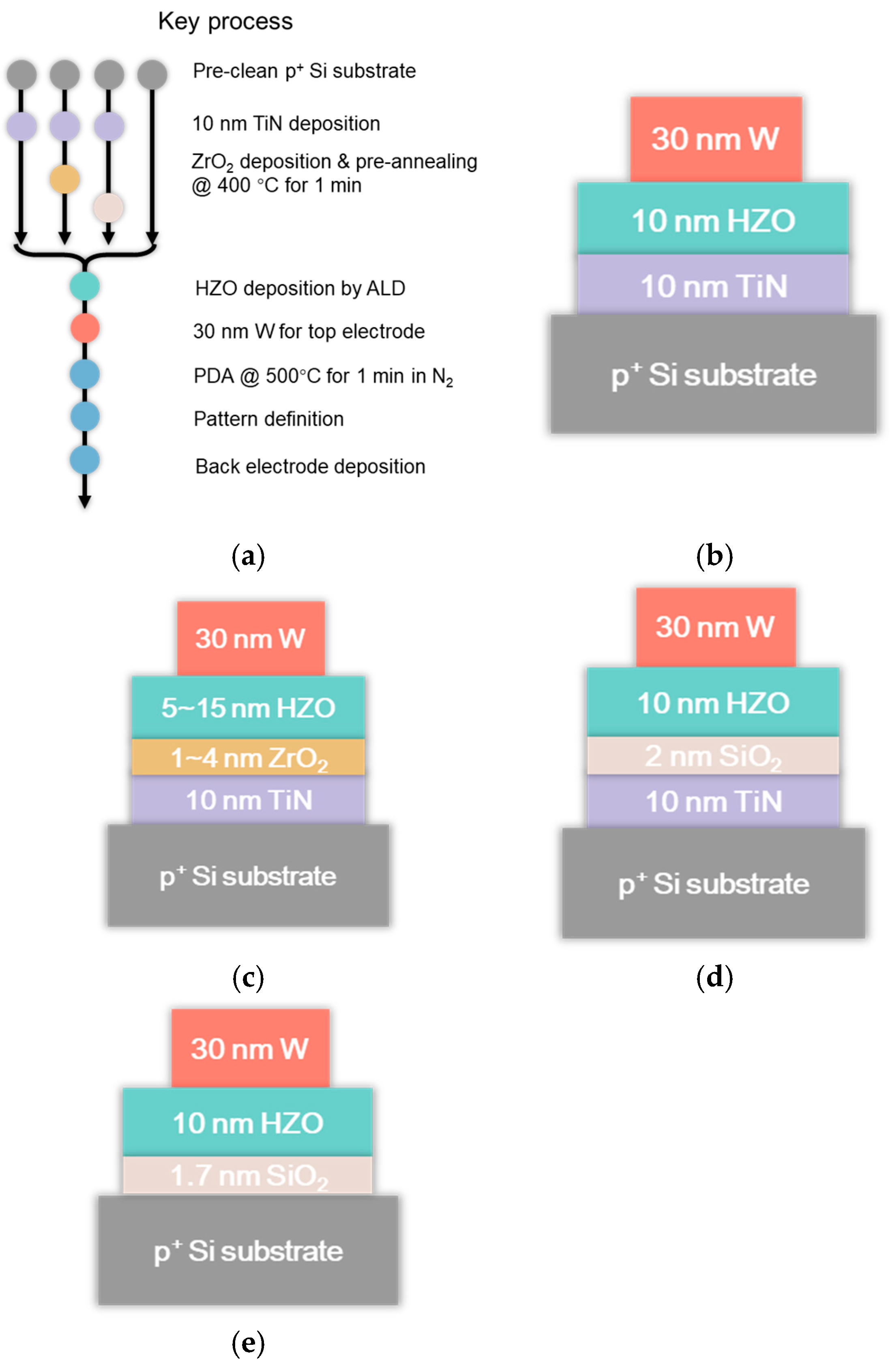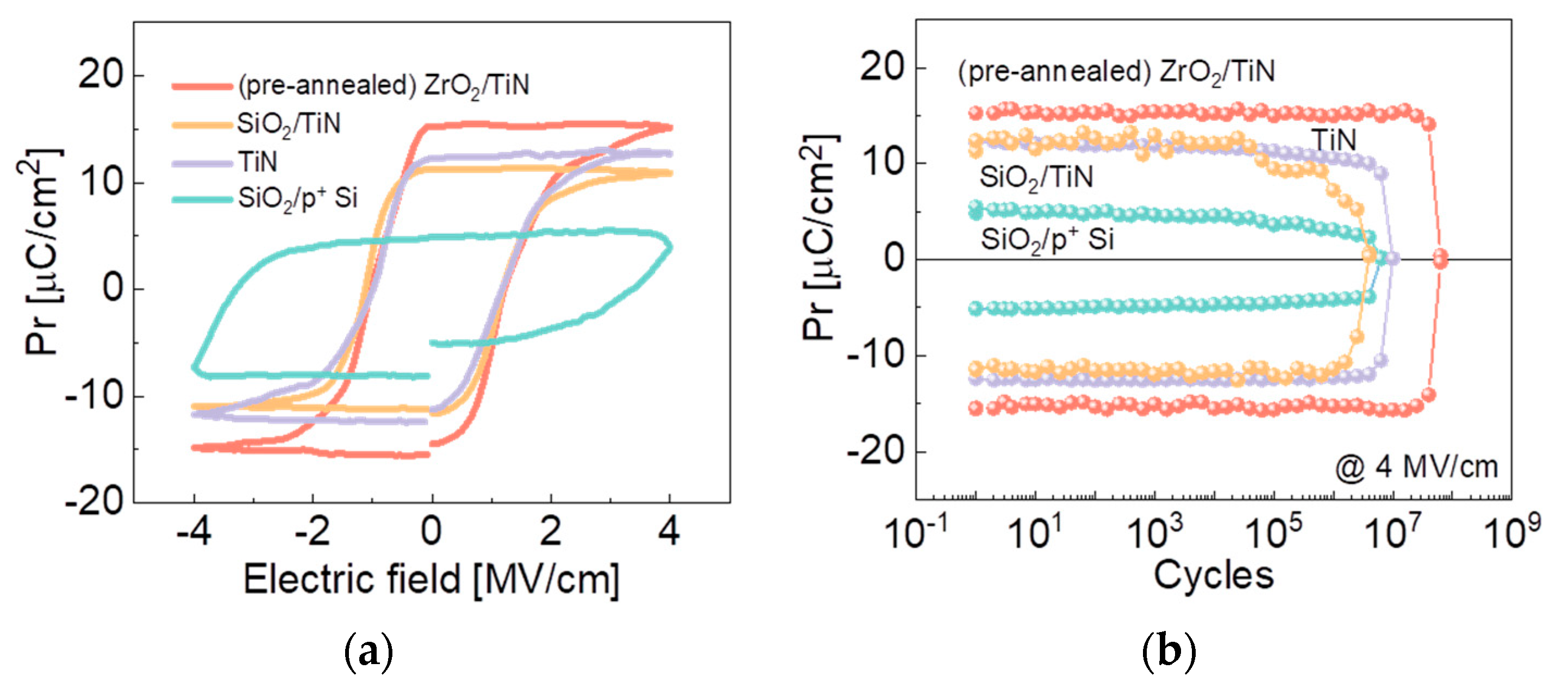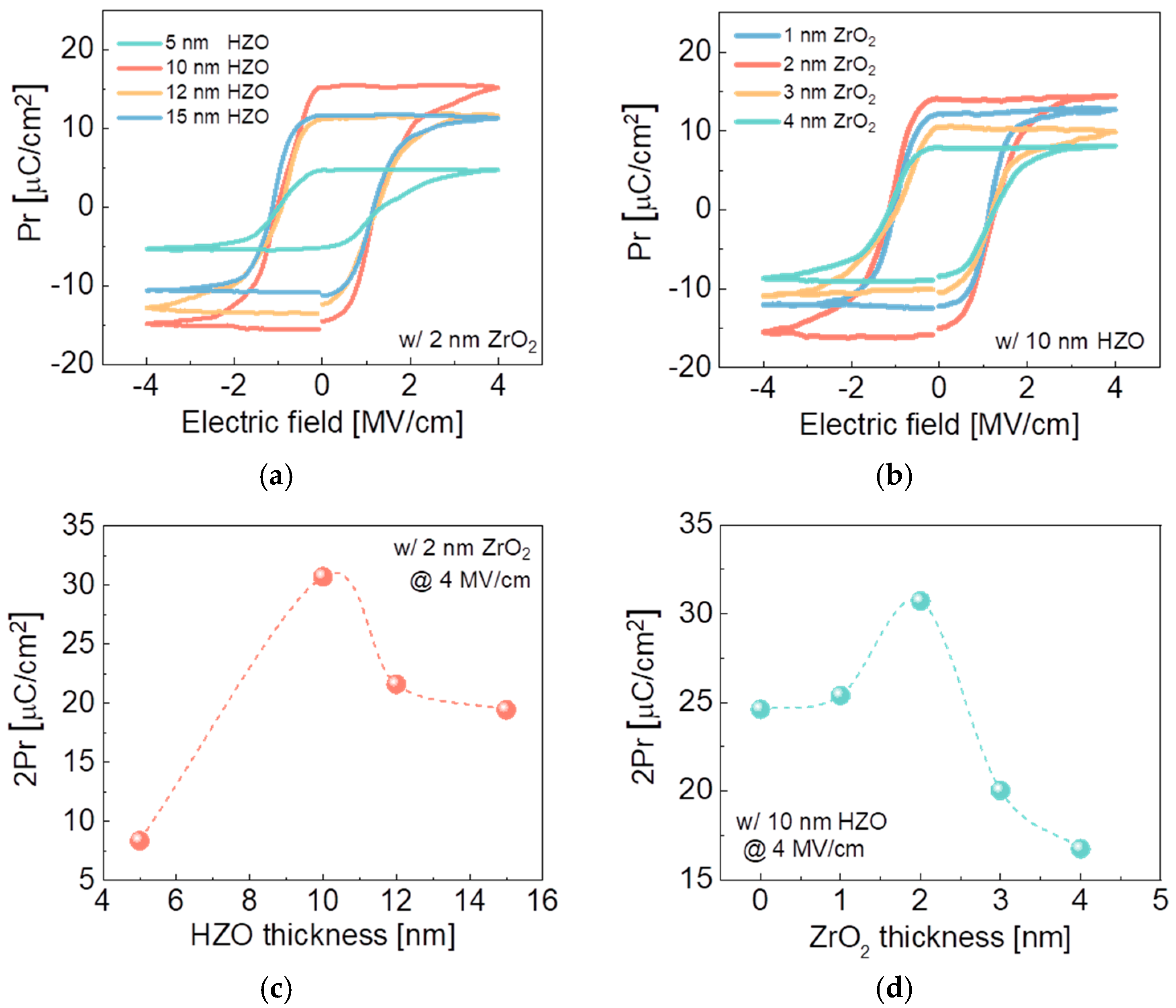Impact of Pre-Annealed ZrO2 Interfacial Layer on the Ferroelectric Behavior of Hf0.5Zr0.5O2
Abstract
:1. Introduction
2. Materials and Methods
3. Results
4. Conclusions
Author Contributions
Funding
Data Availability Statement
Acknowledgments
Conflicts of Interest
References
- Böscke, T.S.; Müller, J.; Bräuhaus, D.; Schröder, U.; Böttger, U. Ferroelectricity in hafnium oxide thin films. Appl. Phys. Lett. 2011, 99, 102903. [Google Scholar] [CrossRef]
- Müller, J.; Böscke, T.S.; Müller, S.; Yurchuk, E.; Polakowski, P.; Paul, J.; Martin, D.; Schenk, T.; Khullar, K.; Kersch, A.; et al. Ferroelectric hafnium oxide: A CMOS-compatible and highly scalable approach to future ferroelectric memories. In Proceedings of the 2013 IEEE International Electron Devices Meeting, Washington, DC, USA, 9–11 December 2013; pp. 10.8.1–10.8.4. [Google Scholar] [CrossRef]
- Hur, J.; Luo, Y.-C.; Tasneem, N.; Khan, A.I.; Yu, S. Ferroelectric Hafnium Zirconium Oxide Compatible With Back-End-of-Line Process. IEEE Trans. Electron Devices 2021, 68, 3176–3180. [Google Scholar] [CrossRef]
- Dutta, S.; Ye, H.; Khandker, A.A.; Kirtania, S.G.; Khanna, A.; Ni, K.; Datta, S. Logic compatible high-performance ferroelectric transistor memory. IEEE Electron Device Lett. 2022, 43, 382–385. [Google Scholar] [CrossRef]
- Chernikova, A.G.; Kozodaev, M.G.; Negrov, D.V.; Korostylev, E.V.; Park, M.H.; Schroeder, U.; Hwang, C.S.; Markeev, A.M. Improved Ferroelectric Switching Endurance of La-Doped Hf0.5Zr0.5O2 Thin Films. ACS Appl. Mater. Interfaces 2018, 10, 2701–2708. [Google Scholar] [CrossRef] [PubMed]
- Ambriz-Vargas, F.; Kolhatkar, G.; Thomas, R.; Nouar, R.; Sarkissian, A.; Gomez-Yáñez, C.; Gauthier, M.; Ruediger, A. Tunneling electroresistance effect in a Pt/Hf0.5Zr0.5O2/Pt structure. Appl. Phys. Lett. 2017, 110, 093106. [Google Scholar] [CrossRef]
- Kim, S.J.; Narayan, D.; Lee, J.; Mohan, J.; Lee, J.S.; Lee, J.; Kim, H.S.; Byun, Y.; Lucero, A.T.; Young, C.D.; et al. Large ferroelectric polarization of TiN/Hf0.5Zr0.5O2/TiN capacitors due to stress-induced crystallization at low thermal budget. Appl. Phys. Lett. 2017, 111, 242901. [Google Scholar] [CrossRef]
- Wang, Y.; Huang, F.; Hu, Y.; Cao, R.; Shi, T.; Liu, Q.; Bi, L.; Liu, M. Proton radiation effects on Y-doped HfO2-based ferroelectric memory. IEEE Electron Device Lett. 2018, 39, 823–826. [Google Scholar] [CrossRef]
- Mueller, S.; Mueller, J.; Singh, A.; Riedel, S.; Sundqvist, J.; Schroeder, U.; Mikolajick, T. Incipient ferroelectricity in Al-doped HfO2 thin films. Adv. Funct. Mater. 2012, 22, 2412–2417. [Google Scholar] [CrossRef]
- Martin, D.; Müller, J.; Schenk, T.; Arruda, T.M.; Kumar, A.; Strelcov, E.; Yurchuk, E.; Müller, S.; Pohl, D.; Schröder, U.; et al. Ferroelectricity in Si-doped HfO2 revealed: A binary lead-free ferroelectric. Adv. Mater. 2014, 26, 8198–8202. [Google Scholar] [CrossRef]
- Park, M.H.; Lee, Y.H.; Kim, H.J.; Kim, Y.J.; Moon, T.; Kim, K.D.; Müller, J.; Kersch, A.; Schroeder, U.; Mikolajick, T. Ferroelec tricity and antiferroelectricity of doped thin HfO2-based films. Adv. Mater. 2015, 27, 1811–1831. [Google Scholar] [CrossRef]
- Lowther, J.E.; Dewhurst, J.K.; Leger, J.M.; Haines, J. Relative stability of ZrO2 and HfO2 structural phases. Phys. Rev. B Condens. Matter. 1999, 60, 14485–14488. [Google Scholar] [CrossRef]
- Huan, T.D.; Sharma, V.; Rossetti, G.A.; Ramprasad, R. Path ways towards ferroelectricity in hafnia. Phys. Rev. B Condens. Matter. 2014, 90, 064111. [Google Scholar] [CrossRef]
- Min, H.P.; Lee, Y.H.; Mikolajick, T.; Schroeder, U.; Hwang, C.S. Review and perspective on ferroelectric HfO2-based thin films for memory applications. MRS Commun. 2018, 8, 795–808. [Google Scholar] [CrossRef]
- Cao, R.; Liu, Q.; Liu, M.; Song, B.; Shang, D.; Yang, Y.; Luo, Q.; Wu, S.; Li, Y.; Wang, Y.; et al. Improvement of endurance in HZO-based ferroelectric capacitor using Ru electrode. IEEE Electron Device Lett. 2019, 40, 1744–1747. [Google Scholar] [CrossRef]
- Sun, C.-J.; Yao, Y.-J.; Yan, S.-C.; Lin, Y.-W.; Lin, S.-W.; Hou, F.-J.; Luo, G.-L.; Wu, Y.-C. Investigation of SiGe/Si Bilayer Inverted-T Channel Gate-All-Around Field-Effect-Transistor With Self-Induced Ferroelectric Ge Doped HfO2. IEEE J. Electron Devices Soc. 2022, 10, 408–412. [Google Scholar] [CrossRef]
- Li, J.; Su, M.; Weng, Z.; Lan, Z.; Lee, C.; Zhao, Y. Impact of Bottom Electrode Crystallinity on Ferroelectricity of La-Doped HfO2. IEEE Electron Device Lett. 2023, 44, 1833–1836. [Google Scholar] [CrossRef]
- Lomenzo, P.-Y.; Takmeel, Q.; Fancher, C.-M.; Zhou, C.; Rudawski, N.-H.; Moghaddam, S.; Jones, J.-L.; Nishida, T. Ferroelectric Si-Doped HfO2 Device Properties on Highly Doped Germanium. IEEE Electron Device Lett. 2015, 36, 766–768. [Google Scholar] [CrossRef]
- Onaya, T.; Nabatame, T.; Sawamoto, N.; Ohi, A.; Ikeda, N.; Chikyow, T.; Ogura, A. Improvement in ferroelectricity of HfxZr1−xO2 thin films using ZrO2 seed layer. Appl. Phys. Exp. 2017, 10, 081501. [Google Scholar] [CrossRef]
- Onaya, T.; Nabatame, T.; Inoue, M.; Sawada, T.; Ota, H.; Morita, Y. Wake-up-free properties and high fatigue resistance of HfxZr1−xO2- based metal–ferroelectric–semiconductor using top ZrO2 nucleation layer at low thermal budget (300 °C). APL Mater. 2022, 10, 051110. [Google Scholar] [CrossRef]
- Onaya, T.; Nabatame, T.; Inoue, M.; Jung, Y.C.; Hernandez-Arriaga, H.; Mohan, J.; Kim, H.S.; Sawamoto, N.; Nagata, T.; Kim, J.; et al. Improvement in ferroelectricity and breakdown voltage of over 20-nmthick HfxZr1−xO2/ZrO2 bilayer by atomic layer deposition. Appl. Phys. Lett. 2020, 117, 232902. [Google Scholar] [CrossRef]
- Onaya, T.; Nabatame, T.; Sawamoto, N.; Ohi, A.; Ikeda, N.; Nagata, T.; Ogura, A. Improvement in ferroelectricity of HfxZr1−xO2 thin films using top- and bottom-ZrO2 nucleation layers. APL Mater. 2019, 7, 061107. [Google Scholar] [CrossRef]
- Chen, Y.-F.; Hu, C.-W.; Kao, Y.-C.; Kuo, C.-Y.; Wu, P.-J.; Wu, Y.-H. Wake-Up Free Ferroelectric Capacitor With Quadruple-Level Storage by Inserting ZrO2 Interlayer and Bottom Layer in HfZrOx. IEEE Electron Device Lett. 2023, 44, 400–403. [Google Scholar] [CrossRef]
- Lee, S.; Kim, M.; Lee, T.; Lee, T.; Bong, J.; Shin, S.; Kim, S.; Hwang, W.; Cho, B. Effect of ZrO2 interfacial layer on forming ferroelectric HfxZryOz on Si substrate. AIP Adv. 2019, 9, 125020. [Google Scholar] [CrossRef]
- Toprasertpong, K.; Tahara, K.; Takenaka, M.; Takagi, S. Evaluation of polarization characteristics in metal/ferroelectric/semiconductor capacitors and ferroelectric field-effect transistors. Appl. Phys. Lett. 2020, 116, 242903. [Google Scholar] [CrossRef]
- Tasneem, N.; Islam, M.M.; Wang, Z.; Chen, H.; Hur, J.; Triyoso, D.; Consiglio, S.; Tapily, K.; Clark, R.; Leusink, G.; et al. The Impacts of Ferroelectric and Interfacial Layer Thicknesses on Ferroelectric FET Design. IEEE Electron Device Lett. 2021, 42, 1156–1159. [Google Scholar] [CrossRef]




Disclaimer/Publisher’s Note: The statements, opinions and data contained in all publications are solely those of the individual author(s) and contributor(s) and not of MDPI and/or the editor(s). MDPI and/or the editor(s) disclaim responsibility for any injury to people or property resulting from any ideas, methods, instructions or products referred to in the content. |
© 2023 by the authors. Licensee MDPI, Basel, Switzerland. This article is an open access article distributed under the terms and conditions of the Creative Commons Attribution (CC BY) license (https://creativecommons.org/licenses/by/4.0/).
Share and Cite
Yuan, X.; Liu, Z.; Qi, J.; Xiao, J.; He, H.; Tang, W.; Lee, C.; Zhao, Y. Impact of Pre-Annealed ZrO2 Interfacial Layer on the Ferroelectric Behavior of Hf0.5Zr0.5O2. Electronics 2024, 13, 3. https://doi.org/10.3390/electronics13010003
Yuan X, Liu Z, Qi J, Xiao J, He H, Tang W, Lee C, Zhao Y. Impact of Pre-Annealed ZrO2 Interfacial Layer on the Ferroelectric Behavior of Hf0.5Zr0.5O2. Electronics. 2024; 13(1):3. https://doi.org/10.3390/electronics13010003
Chicago/Turabian StyleYuan, Xiaobo, Zongfang Liu, Jiabin Qi, Jinpan Xiao, Huikai He, Wentao Tang, Choonghyun Lee, and Yi Zhao. 2024. "Impact of Pre-Annealed ZrO2 Interfacial Layer on the Ferroelectric Behavior of Hf0.5Zr0.5O2" Electronics 13, no. 1: 3. https://doi.org/10.3390/electronics13010003




